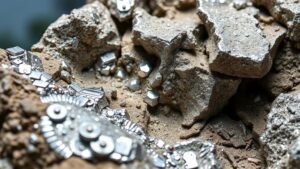Identifying Gold in Iron-Stained Sediments Using Simple Tests
Identifying Gold in Iron-Stained Sediments Using Simple Tests
The pursuit of gold has captivated human interest for centuries, leading to a multitude of methods for identification and extraction. With the increasing popularity of recreational gold prospecting, understanding how to effectively identify gold in iron-stained sediments using simple tests is essential for enthusiasts and professionals alike. This article delves into practical methodologies for gold identification, emphasizing techniques that can be implemented in the field with minimal equipment.
Understanding Iron-Stained Sediments
Iron-stained sediments typically manifest as reddish or yellowish deposits, often found in riverbeds or areas with historical mining activity. e stains are primarily composed of iron oxides, which create a distinct backdrop that can mask the presence of gold. Proper identification methods can help distinguish gold from other materials in these sediments.
Characteristics of Gold in Sediments
Gold often appears in a variety of forms within iron-stained sediments, including flakes, nuggets, and fine particles. Its unique properties–such as density and luster–can facilitate its identification. For example, golds density (approximately 19.3 g/cm³) is significantly greater than that of iron oxide, which can weigh around 5.2 g/cm³. This disparity in weight allows for simple separation techniques, essential for prospecting.
Simple Tests for Identifying Gold
There are several straightforward tests that can assist in identifying gold within iron-stained sediments. These methods are applicable with common tools found in typical prospecting kits.
1. Visual Inspection
Before employing any physical tests, conduct a thorough visual inspection of the sediment.
- Look for shiny, yellowish colors, which may indicate gold.
- Inspect the shape of the particles; gold typically has a distinctive malleable form.
2. Density Test
The density test is a key method due to the significant difference in density between gold and its surrounding sediments. To perform this test:
- Fill a container with water and measure its weight.
- Place a sample of the sediment into the water and note the change in water level.
- Calculate the weight of the sediment using the displacement method: weight of water + sediment – initial water weight.
If the displacement indicates a much heavier sample, it may contain gold. A case study in the Sierra Nevada region showed that using the density test helped identify gold-bearing quartz during prospecting expeditions.
3. Streak Test
A streak test can provide immediate indications of gold’s presence.
- Smooth a piece of unglazed porcelain over the sediment sample.
- If the sample leaves a yellow streak, it may confirm the presence of gold.
This test relies on the fact that gold leaves a characteristic streak, contrasting with other metals which typically leave different colored marks.
Real-World Applications and Considerations
These simple tests can be invaluable for individuals engaged in small-scale prospecting. For example, in many areas of California, gold panning remains a popular activity, with enthusiasts utilizing these tests reliably. While these methods do not guarantee success, they can significantly increase the likelihood of identifying gold in iron-stained sediments.
But, it’s important to note that extraction laws may vary by location, and prospectors should always adhere to local regulations to avoid legal repercussions.
Conclusion and Actionable Takeaways
Identifying gold in iron-stained sediments does not require advanced technology or extensive training. Through simple tests such as visual inspection, density testing, and streak testing, individuals can effectively search for gold while enjoying the outdoors. With this foundational knowledge, prospectors are better equipped to identify potential gold deposits and contribute to the rich history of gold exploration.
For best practices, consider the following actionable takeaways:
- Familiarize yourself with the characteristics of gold.
- Carry basic prospecting tools, including a scale and unglazed porcelain plate.
- Adhere to local mining regulations and best practices for ethical prospecting.
